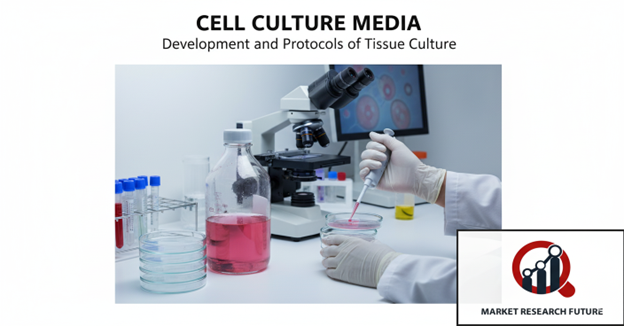Cell Culture Media - Development and Protocols of Tissue Culture

Cell Cture Media Overview
Cell culture media plays a pivotal role in modern biotechnology by providing the nutrients and controlled environment necessary for the growth, maintenance, and proliferation of cells outside their natural habitat. Acting as the foundation of tissue culture technology, it supports the study of cellular physiology, drug discovery, vaccine development, and therapeutic innovations.
The Cell Culture Media Market was valued at 7.07 USD Billion in 2023 and is projected to grow to 15 USD Billion by 2035, with a CAGR of 6.47 percent from 2025 to 2035, driven by rising pharmaceutical R&D, biopharmaceutical production, and the increasing demand for advanced therapeutics.
Types of Cell Culture Media
1. Natural Media
Derived from animal tissue extracts or bodily fluids, natural media supply essential nutrients directly. Categories include:
- Biological fluids: serum, plasma, lymph, amniotic fluid
- Tissue extracts: liver, tumor, embryo, bone marrow
- Clots and coagulants
2. Synthetic (Artificial) Media
Designed to mimic physiological conditions more consistently, synthetic media include:
- Media with serum – enhanced with growth factors from animal serum.
- Serum-free media (SFM) – reduces variability, ensuring controlled growth.
- Chemically defined media – composed of pure ingredients, minimizing contamination.
- Balanced Salt Solutions (BSS) – foundational formulations enriched with nutrients for advanced culture systems.
Key Applications
Cell culture technology is integral across multiple domains:
- Biomedical research – studying physiology, metabolism, aging, and carcinogenesis.
- Drug discovery and testing – screening compounds for efficacy and toxicity
- Vaccine production – including COVID-19 and influenza vaccines.
- Biopharmaceuticals – large-scale production of therapeutic proteins and monoclonal antibodies
- Gene therapy research – development of advanced regenerative treatments
The consistency, reproducibility, and scalability of results make cell culture indispensable for both academic and industrial research.
Market Challenges
Despite its growth potential, the market faces notable challenges:
- High costs – advanced equipment, reagents, and R&D demand significant investment
- Environmental concerns – heavy use of plastics in consumables, with limited recycling options
- Technical limitations – ensuring contamination-free, scalable, and reproducible results remains a hurdle.
Ongoing innovations in bioprocessing and sustainable culture systems aim to address these concerns.
Regional Analysis
North America currently leads the global cell culture media market, driven by a strong biopharmaceutical pipeline, robust government funding initiatives, and the presence of leading biotechnology companies. The United States, in particular, has established itself as a hub for innovation in vaccine development, regenerative medicine, and gene therapy research, making it the single largest contributor to regional growth.
Europe follows closely, supported by well-developed healthcare systems, EU-backed research programs, and the rising adoption of advanced regenerative therapies. Within Europe, Germany, the United Kingdom, and Switzerland stand out as prominent centres of biotechnology innovation and pharmaceutical advancement.
Meanwhile, the Asia-Pacific region is witnessing the fastest growth, fuelled by increasing investments in healthcare infrastructure, expanding pharmaceutical outsourcing, and rising government support for biotechnology research. Countries such as China, India, and South Korea are emerging as significant players, particularly in affordable large-scale bioproduction and vaccine development.
Latin America is also gradually expanding its footprint in the market, with Brazil and Mexico at the forefront of academic research and vaccine manufacturing, although challenges related to infrastructure and funding still pose limitations.
In the Middle East and Africa, growth remains modest but promising, with countries like Saudi Arabia, the United Arab Emirates, and South Africa making strategic investments to strengthen their biopharma and healthcare sectors.
Impact of COVID-19
The pandemic significantly accelerated the adoption of cell culture media technologies, particularly in vaccine development. Pharmaceutical companies leveraged these systems to design, test, and scale COVID-19 vaccines rapidly, boosting global demand. The heightened awareness of pandemic preparedness is expected to sustain demand for advanced cell culture solutions in the years ahead.
Conclusion
The cell culture media market is at the forefront of biomedical innovation, powering advancements in vaccines, drug discovery, gene therapy, and biopharmaceutical manufacturing. While challenges such as cost and environmental sustainability persist, continuous innovation is expected to drive robust growth. With regional markets evolving at different paces, the global outlook remains strong, positioning cell culture media as a cornerstone of future healthcare solutions.

Leave a Comment